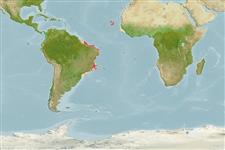>
Eupercaria/misc (Various families in series Eupercaria) >
Labridae (Wrasses) > Corinae
Etymology: Thalassoma: Greek, thalassa = the sea + Greek, soma = body; the colour of the sea (Ref. 45335).
More on author: Boulenger.
Environment: milieu / climate zone / depth range / distribution range
экология
морской ассоциированный с рифами; пределы глубины 0 - 60 m (Ref. 49354), usually 2 - 5 m (Ref. 40101). Tropical
Western Atlantic: Brazil and its oceanic islands (Ref. 40101, 49354).
Size / Вес / Возраст
Maturity: Lm ? range ? - ? cm
Max length : 13.3 cm SL самец/пол неопределен; (Ref. 49354)
Generally a plankton-eater. Found on deep reefs (40-60 m), where it is recorded inside the lumen of tubular sponges (Ref. 39606). At Fernando de Noronha and Trindade Islands, groups of 10-450 initial-phase individuals clean other fishes in the water column close to the reef bottom and pinnacles (Ref. 36301, 49354). Also at Fernando de Noronha Archipelago, juveniles follow foraging green turtles (Chelonia mydas) and pick off particles stirred from the bottom by the turtle’s activity (Ref. 51385). Fish clients include about 20 species of surgeonfishes, damselfishes, parrotfishes, grunts, and even small groupers such as coneys. Occasionally, a coney (Cephalopholis fulva) preys on isolated Noronha wrasses out and away from the cleaning stations. Coastal individuals were never recorded cleaning. Strictly diurnal, this wrasse is one of the last reef fishes to emerge from nocturnal shelters and one of the first to retreat (Ref. 36301). Initial-phase individuals are predominantly dark-brown and white, whereas terminal-phase males are blue and purple. A group-spawner throughout the year, adult females form harems dominated by a few terminal-phase males. Pair spawning is also recorded for this wrasse (Ref. 49354). Traded as an aquarium fish at Ceará, Brazil (Ref. 49392).
Life cycle and mating behavior
половая зрелость | размножение | нерест | икра | Fecundity | личинки
Oviparous, distinct pairing during breeding (Ref. 205).
Lubbock, R. and A. Edwards, 1981. The fishes of Saint Paul's Rocks. J. Fish Biol. 18(2):135-157. (Ref. 13121)
Статус Красного Списка МСОП (Ref. 130435)
Угроза для людей
Harmless
Использование человеком
аквариум: коммерческий
дополнительная информация
ссылкиаквакультура (рыбоводство)особенности рыбоводствастепень растяжениягенетикаElectrophoresesнаследуемостьболезниобработкаNutrientsMass conversion
соавторыизображенияStamps, Coins Misc.звукиCiguateraскоростьтип плаванияжаберная областьOtolithsмозгзрение
инструменты
Специальные отчеты
Скачать в формате XML
ресурсы в Интернет
Estimates based on models
Preferred temperature (Ref.
123201): 23.8 - 27.6, mean 27 °C (based on 184 cells).
Phylogenetic diversity index (Ref.
82804): PD
50 = 0.5000 [Uniqueness, from 0.5 = low to 2.0 = high].
Bayesian length-weight: a=0.00646 (0.00315 - 0.01323), b=3.13 (2.95 - 3.31), in cm total length, based on LWR estimates for this species & (Sub)family-body (Ref.
93245).
Trophic level (Ref.
69278): 3.4 ±0.4 se; based on size and trophs of closest relatives
устойчивость к внешним воздействиям (Ref.
120179): высокий, минимальное время удвоения популяции до 15 месяцев (Preliminary K or Fecundity.).
Fishing Vulnerability (Ref.
59153): Low vulnerability (10 of 100).
